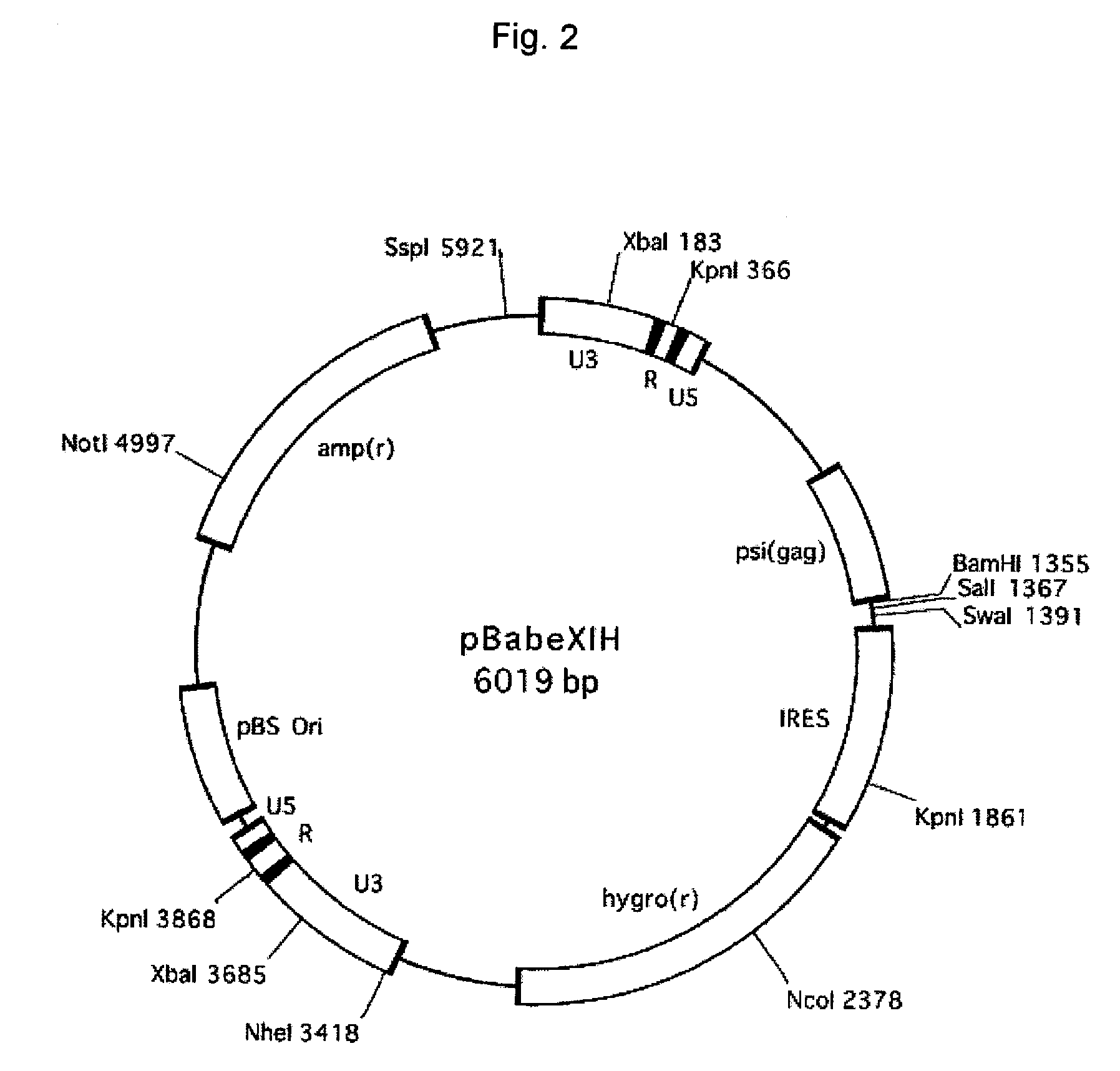Herg channel-expressing cell
a herg channel and cell technology, applied in the field of cell evaluation, can solve the problems of requiring highly skilled technology, a large number of candidate compounds, and a large number of compounds, and achieve the effects of high herg channel expression level, high throughput evaluation, and high sensitiveness
- Summary
- Abstract
- Description
- Claims
- Application Information
AI Technical Summary
Benefits of technology
Problems solved by technology
Method used
Image
Examples
example 1
Preparation of hERG Gene
[0110] A hERG gene was isolated as described below by using the nucleotide sequence as shown in SEQ ID NO: 1 as a basis. In this sequence, 4070 bps are shown in which the region encoding a hERG channel (excluding the stop codon) is said nucleotides 184 to 3660 (3477 bps, 1159 amino acid residues) (GenBank Accession No. U04270). In order to isolate the gene by PCR (polymerase chain reaction), oligo DNA primers as shown in SEQ ID NO: 3 to 8 were prepared by Japan Bio Service (Asaka City, Saitama) upon request of the inventors.
[0111] cDNA was prepared by using human brain polyA+ RNA (Clontech, Palo Alto, Calif., catalog #6516-1) as a template with Superscript First-Strand Synthesis System (Invitrogen / Gibco, MD). Subsequently, by using the resultant cDNA as a template and oligo DNAs consisting of SEQ ID NO: 3 and 4, SEQ ID NO: 5 and 6 and SEQ ID NO: 7 and 8 as primers, PCR reactions were performed with Expand High Fidelity PCR System (Roche Diagnostics, Mannhei...
example 2
Preparation of Retrovirus Vector Plasmids
[0117] pBabe Puro (Morgenstern, J. P. and Land, H., Nucleic Acids Res. vol. 18 3587-3596) (SEQ ID NO: 13) was digested with restriction enzymes SalI and ClaI to remove SV40 promoter-puro(r) and then blunt-ended with Klenow fragment (Takara, Otsu, Japan). Into this site, IRES-puro(r) that had been cut out from pRESpuro (Clontech, Palo Alto, Calif., catalog #6031-1) with restriction enzymes NsiI and XbaI and then blunt-ended with T4 polymerase was inserted to thereby obtain pBabeXIP (FIG. 1).
[0118] pBabe Puro (Morgenstern, J. P. and Land, H., Nucleic Acids Res. vol. 18 3587-3596) (SEQ ID NO: 13) was digested with SalI and ClaI to remove SV40 promoter-puro(r) and then blunt-ended with Klenow fragment. Into this site, IRES-hyg(r) that had been cut out from pIREShyg (Clontech, Palo Alto, Calif., catalog #6061-1) with restriction enzymes NsiI and XbaI and then blunt-ended with T4 polymerase was inserted to thereby obtain pBabeXIH (FIG. 2).
[0119]...
example 3
Preparation of Retrovirus Vector Plasmids for hERG Gene Transfer
[0123] pBabeCLXaIN obtained in Example 2 was digested with restriction enzyme HpaI. Into this site, a hERG gene that had been cut out from pREP7hERG (obtained in Example 1) with KpnI and HindIII and then blunt-ended with T4 polymerase was inserted to thereby obtain pBabeCL(hERG)aIN (FIG. 7).
[0124] pBabeCLXIH obtained in Example 2 was digested with HpaI. Into this site, a hERG gene that had been cut out from pREP7hERG (obtained in Example 1) with KpnI and HindIII and then blunt-ended with T4 polymerase was inserted to thereby obtain pBabeCL(hERG)IH (FIG. 8).
[0125] pBabeCLXIP obtained in Example 2 was digested with HpaI. Into this site, a hERG gene that had been cut out from pREP7hERG (obtained in Example 1) with KpnI and HindIII and then blunt-ended with T4 polymerase was inserted to thereby obtain pBabeCL(hERG)IP (FIG. 9).
[0126] pBabeCLXI2G obtained in Example 2 was digested with HpaI. Into this site, a hERG gene th...
PUM
| Property | Measurement | Unit |
|---|---|---|
| Fraction | aaaaa | aaaaa |
| Current | aaaaa | aaaaa |
| Current | aaaaa | aaaaa |
Abstract
Description
Claims
Application Information
 Login to View More
Login to View More - R&D
- Intellectual Property
- Life Sciences
- Materials
- Tech Scout
- Unparalleled Data Quality
- Higher Quality Content
- 60% Fewer Hallucinations
Browse by: Latest US Patents, China's latest patents, Technical Efficacy Thesaurus, Application Domain, Technology Topic, Popular Technical Reports.
© 2025 PatSnap. All rights reserved.Legal|Privacy policy|Modern Slavery Act Transparency Statement|Sitemap|About US| Contact US: help@patsnap.com



